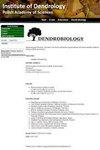Coping with Central European climate – xylem adjustment in seven non-native conifer tree species
IF 1.8
4区 农林科学
Q2 FORESTRY
引用次数: 6
Abstract
The introduction of tree species raises the question of whether they find suitable conditions in their secondary range and whether they can successfully adapt to the new conditions in the context of an unstable climate. Stem secondary growth of trees and the changes in xylem cell structure make it possible to trace the adaptation process to the new climate on an inter- and intra-seasonal scale. The objective of this study was to determine whether the seven non-native conifer species in Central Europe differ in climate sensitivity and to what extent late frost and spring-summer drought can influence xylem changes. In our study, we investigated the growth pattern and xylem cell structure modifications of seven introduced conifer species Pseudotsuga menziesii, Pinus strobus, Tsuga canadensis, Abies grandis, Pinus banksiana, Pinus rigida, Pinus nigra, growing under uniform conditions in Poland. To determine species-specific temporal variations in climate sensitivity, we used stationary and non-stationary correlations of ring width with daily climate variables: mean, minimum, and maximum temperatures, precipitation sum, and SPEI, supported by a pointer-year analysis. Changes in xylem structure (frost rings and intra-annual density fluctuations) were analyzed using light and fluorescence microscopy. Warming of the winter-spring period benefits both southern European and North American introduced conifers, as reflected in the extended responsiveness period. However, as the growing season warms and the risk of late frosts increases, the potential for acclimatization of non-native species decreases, especially with respect to their juvenile growth phase. Negative precipitation and evapotranspiration balance at spring-summer period can lead to reduced growth and anomalies in earlywood xylem structure, commonly referred to as intra annual density fluctuations. P. strobus, the species that loses both frost-induced cambium damage and drought-induced xylem anomalies in summer is the fastest growing non-native species, along with P. menziesii. Although the results presented here show the potential and the limitations in the acclimatization of coniferous species, the obvious limitations related to local environmental conditions and the different ages of the trees make us cautious in generalizing the conclusions. Therefore, we call for the creation of a pan-European dendro-network of sites of non-native coniferous species.应对中欧气候——七种非本土针叶树的木质部调整
树种的引入提出了一个问题,即它们是否在次生范围内找到了合适的条件,以及在气候不稳定的情况下能否成功适应新的条件。树木的茎次生生长和木质部细胞结构的变化使我们有可能在季节间和季节内追踪对新气候的适应过程。这项研究的目的是确定中欧的七种非本土针叶树物种在气候敏感性方面是否存在差异,以及晚霜和春夏干旱对木质部变化的影响程度。在我们的研究中,我们调查了7个引进的针叶树物种在波兰均匀条件下生长的生长模式和木质部细胞结构的改变。为了确定气候敏感性的物种特异性时间变化,我们使用了环宽与每日气候变量的平稳和非平稳相关性:平均、最低和最高温度、降水量总和和SPEI,并得到了指针年分析的支持。木质部结构的变化(霜环和年内密度波动)用光和荧光显微镜进行了分析。冬春季节的变暖对南欧和北美引进的针叶树都有好处,这反映在反应期的延长上。然而,随着生长季节的变暖和晚霜风险的增加,非本土物种适应的可能性降低,尤其是在其幼年生长阶段。春夏季节的负降水和蒸散平衡会导致早期木材木质部结构的生长减少和异常,通常称为年内密度波动。在夏季失去霜冻引起的形成层损伤和干旱引起的木质部异常的P.strobus是生长最快的非本土物种,与P.menziesii一样。尽管本文的结果显示了针叶树物种驯化的潜力和局限性,但与当地环境条件和不同树龄有关的明显局限性使我们在推广结论时持谨慎态度。因此,我们呼吁建立一个由非本土针叶树物种组成的泛欧树木网络。
本文章由计算机程序翻译,如有差异,请以英文原文为准。
求助全文
约1分钟内获得全文
求助全文
来源期刊

Dendrobiology
农林科学-林学
CiteScore
2.20
自引率
11.10%
发文量
17
审稿时长
>12 weeks
期刊介绍:
Dendrobiology publishes original research articles and review articles related to the biology of trees and shrubs.
 求助内容:
求助内容: 应助结果提醒方式:
应助结果提醒方式:


